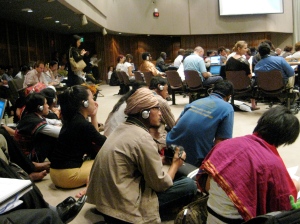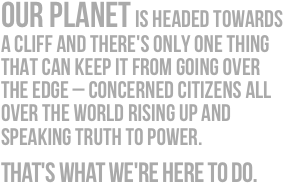by Graham Reeder
This past week (and year), I’ve been following the issue of adaptation. As many of you know, Climate Change is not just a long-term threat that is looming in the horizon; it is being experienced by people now in a very real way. The World Health Organisation estimates that climatic changes are causing 150,000 deaths annually; the vast majority of which are in sub-Saharan Africa.
One of the major, but unpublicised outcomes of Cancun was the groundwork for a new adaptation framework. The Bali Action Plan from 2007 laid out a track for mitigation and adaptation to be considered equally, but this has obviously not been the case. Laying out the Cancun Adaptation Framework is basically the first real step in doing anything sincere about adaptation under the convention. Having said this, the first step has truly been a baby step.
Negotiators have been working out how to incorporate the existing elements of adaptation under the convention, namely the Nairobi Work Programme that sets out to research how adaptation to climate change works and where the vulnerability lies, to fit into the new framework. It looks like the overarching body to oversee adaptation is to be the Adaptation Committee, a group of negotiators who will be responsible for creating coherence among adaptation activities and holding workshops. The composition of that committee is still being worked out; parties disagree about whether emphasis should be on the countries who will be doing the adaptation (developing), or the countries who will be financing that adaptation (developed, but not really). Under the Committee, there will be three branches, the first will be the Nairobi Work Programme, viewed as the scientific and technical arm of adaptation that will mostly do research, the second will be a work programme on Loss and Damage associated with the adverse effects of climate change, and the third will be the formation of National Adaptation Plans (NAPs). All of this will be nicely tied together by the Adaptation Fund, which will work with the Green Climate Fund and other partners to finance all of this bustling activity. But wait; don’t get too excited about all of this action yet, remember that the GCF isn’t operationalized, and probably won’t be for a while, and even if the Adaptation Fund gets operationalized, it remains nearly empty. Rich countries aren’t happy that they don’t have more say over where and how the money in the Adaptation Fund gets spent, so they stubbornly don’t fill it despite their obligation to do so.
But enough about finance, there will be plenty more on that from my colleagues who follow it more closely. There have been some very interesting arguments between parties about the 3 elements of the adaptation framework, work is still being done in back rooms about the adaptation committee, but the chair of the Subsidiary Body for Implementation (Robert-Owen Jones from Australia) is adamant that negotiations should be as transparent as possible and has kept his meetings on adaptation open to observers.
The group of negotiators who work on adaptation (the adaptation community, as they call themselves) are pretty much the same on all issues. A handful of strong negotiators from the US, Australia, the EU, Norway, Bolivia, Argentina, Colombia, the Cook Islands, and Timor Leste dominate most of the talking space. COA’s very own Juan Pablo Hoffmaister (07), one of the founders of Earth In Brackets, is the lead negotiator for the G77+China (a group of 131 developing countries) on issues of adaptation and works tirelessly to coordinate the group and keep it strong. The adaptation community is forwarding several decisions to the COP on the three components of the framework. They have developed a more solid plan for the work programme on loss and damage, after negotiating serious compromise between AOSIS (the Alliance of Small Island States) and the US/Australia on the issue of creating a mechanism to actually do something about it. The US doesn’t think they’re ready to commit to doing anything about loss and damage, saying that they need another year to learn about what it really means and how to deal with it before deciding on anything, while AOSIS is saying that they don’t need another year of sitting around a conference table twiddling their thumbs, they are suffering in terms of millions of dollars and many lives and need the issue to start being addressed as soon as possible. They have ultimately reached a compromise in which the possibility of a mechanism is mentioned, but there is no commitment to actually creating one.
On National Adaptation Plans, the fight has been a little bit more nuanced. Initial division was between developed and developing countries over involvement of the Global Environment Facility as an interim financer until the Green Climate Fund is created, developed countries wanted the GEF to have nothing to do with NAPs because the last round of adaptation programmes (National Adaptation Programmes of Action) that were focused on urgent and immediate adaptation needs were supposed to be implemented by the GEF and still haven’t been 3 years later. Developing countries also wanted to be clear that NAPs couldn’t just be a planning process, but needed to have an implementation component. The Least Developed Countries are sick of seeing money go towards plans that don’t get follow-through. The latest fight is within the G77 itself though, Least Developed Countries (a group of mostly African countries that also includes parties like Bangladesh and Afghanistan) and “particularly vulnerable countries,” a broader group that also includes some Latin American countries are disagreeing about including mentions of particularly vulnerable countries in the text. The LDC group have always been privileged in adaptation text because their capacity to deal with adaptation themselves is the lowest, but that doesn’t mean that they’re the only ones who are vulnerable. This is where finance becomes important, this fight wouldn’t be happening if there was enough money in the pot to go around, but countries are scrambling over the scraps that rich countries have made available. Because of this, the G77 isn’t united on NAPs, making it a lot harder for them to negotiate strongly on the issue. This is most assuredly part of an EU and US (particularly the UK) tactic to divide and conquer the G77.
On the Nairobi Work Programme, most of the fight has been figuring out how to bring it under the Cancun Adaptation Framework. Because it is the only piece of this puzzle that predates the framework, parties are squabbling over how it should fit into the picture. While most developing country parties want to see them report to the Adaptation Committee and start a new phase that is focused on more applicable adaptation needs, developed country parties are happy with the way things have been going and like that it has mostly produced a bunch of academia on adaptation that can’t be applied in very many contexts. After some tough negotiations, negotiators have agreed to start a new phase (the Durban Phase) of the work programme that will have a few of the elements that developing countries wanted, but still won’t be focused on implementation.
Overall I’ve gotten the impression that adaptation negotiations have been going well, they’ve made progress on issues and have (for the most part) worked in the spirit of compromise. That being said, there is absolutely no way that the work that is being produced by the adaptation community reflects the urgency and needs of climate change adaptation on the ground. In my SBI intervention yesterday I tried to stress that youth and other particularly vulnerable groups really don’t have time to sit around and wait for them to squabble over the placement of commas and that what practitioners already know about adaptation needs to be both implemented and funded.

 Currently the language of the negotiating text on REDD is vague; “Forest” can be interpreted as “monocrop plantations.” The “Right to participate” does not mean “Indigenous rights, as some are trying to say. This afternoon The Indigenous Environmental Network rejected having REDD as part of a climate agreement. They call for language in the text that acknowledge the UN Declaration on the Rights of Indigenous Peoples and the principles Free Prior and Informed Consent.
Currently the language of the negotiating text on REDD is vague; “Forest” can be interpreted as “monocrop plantations.” The “Right to participate” does not mean “Indigenous rights, as some are trying to say. This afternoon The Indigenous Environmental Network rejected having REDD as part of a climate agreement. They call for language in the text that acknowledge the UN Declaration on the Rights of Indigenous Peoples and the principles Free Prior and Informed Consent.

